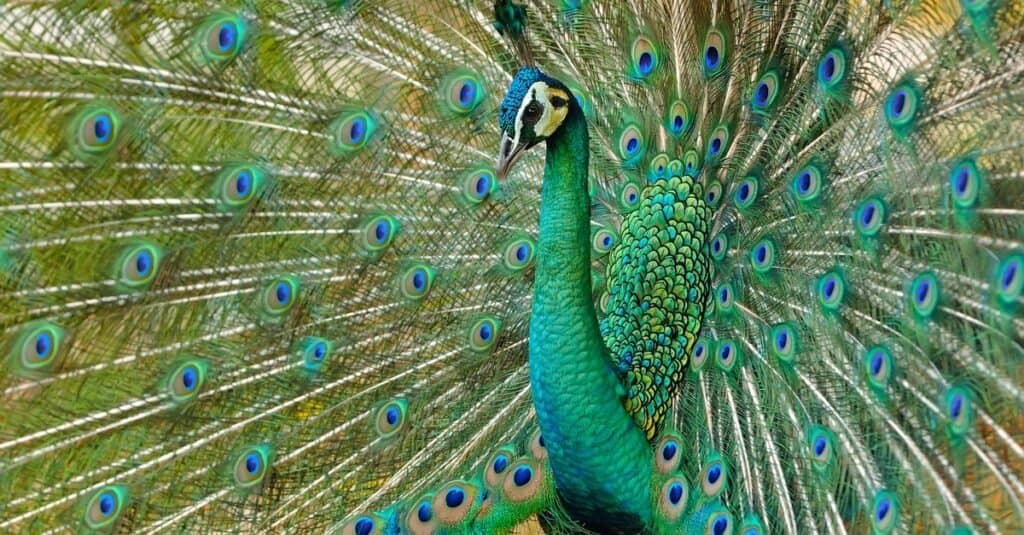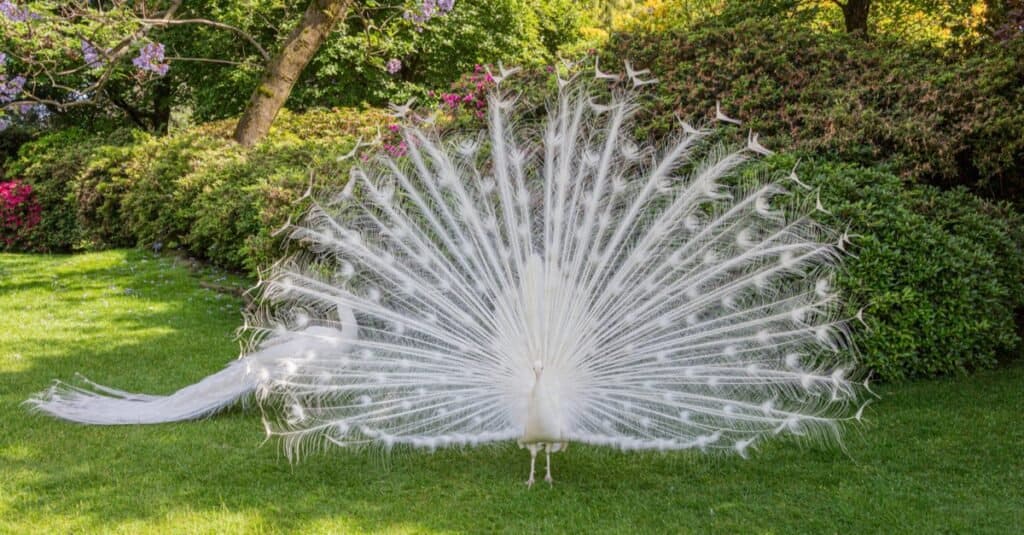Did you know a day has been set aside to celebrate the beauty of peacocks and all things related to them? National Peacock Day is celebrated annually on March 25. In this article, we’ll learn about peacocks and share 25 ways you can celebrate the day in color, fun, and style! And finally, if you really, really love peacocks, we’ll let you know what’s involved in keeping one as a pet.
Fun Facts About Peacocks
- Males are called peacocks; females are peahens. Peafowl is the collective word, but most people call them both peacocks anyway.
- Peahens usually come in neutral colors, but peacocks are brilliant shades of green and blue. Interesting additional fact: blue is the rarest animal color in the world!
- Peacock tail feathers grow up to 5 feet long. Males spread them out to make themselves look bigger to scare off predators as well as impress the ladies with how fancy they look.
- You can eat peafowl, as they are in the pheasant family. They were considered delicacies for the ultra-rich in past cultures. However, the meat is tough and gamey and not popular today.
- They are not endangered and can be found in the wild in Africa and tropical parts of Asia.
- Some folks keep peacocks as pets, but they require specialized care, and unfortunately, their screeching voices are not as beautiful as their plumage.
Description of Peacocks
Peacocks are easily recognizable, and everyone’s favorite, because of their elaborate iridescent plumage. They’re part of the Phasianidae family, which includes chickens, turkeys, and pheasants, and are edible, but tough and gamey. Males are called peacocks and females are peahens, but in everyday speech, most people call both genders peacocks.
The proper term for males and females together is peafowl. Peacock tail feathers can be up to 5 feet long. Males use them to make themselves look like a meal too big to eat for predators, and they also display them to impress females during courtship.
Peahens are much less colorful, with brownish-gray plumage and a shorter tail. This is a good thing, as it helps them stay camouflaged from predators and curious humans with cameras while sitting on eggs and caring for their young.

The appropriate way to refer to both male and female peacocks is ‘peafowl.’ And the appropriate day to celebrate them is on March 25!
©iStock.com/panda3800
Peacocks live in warm regions of Africa and Asia and are also kept as domesticated animals in many parts of the world. Once seen only parading on the grounds of wealthy estates in Europe and America, now you can always find them in zoos, often roaming free, and they’re occasionally kept by regular folks alongside chickens and other domestic fowl.
Though they’re beautiful visually, the sounds they make are often annoying or even alarming to people. They’re often described as loud piercing screeches or screams that can sound at times like a human in danger and be heard a long way away. Even worse, they like to do it early in the morning or late in the evening. Your neighbors will not love them.
Peacock Diet
Peacocks are omnivorous, eating a variety of foods such as seeds, fruits, insects, and even small animals such as mice when they can catch them. They don’t migrate but stick to their territory year-round. They are able to fly for a brief distance, so they have to be enclosed with high fences or in a netted or roofed enclosure to keep them from wandering when kept domesticated.
Peacocks in History and Culture
Peacocks have been important cultural symbols for people in different parts of the world. In India they are considered sacred to the god Krishna and symbolize grace, pride, and beauty. Hindu mythology depicts them as having eyes on their feathers, being all-seeing and all-knowing. Peacock feathers are often used in traditional Indian festivals and ceremonies.
The Greeks and Romans understood peacocks to symbolize beauty and eternal life, due to their ability to shed their feathers and grow new ones every year. The eye-like shapes on peacock tails were associated with the stars of the sky. Peacocks were sacred to the goddess Hera.
Influenced by the Greeks and Romans, early Christians used peacocks as symbols of immortality, connected with the idea of the resurrection of Jesus, and the hope of eternal life for his followers. The peacock was a popular image in church architecture, iconography, and manuscript illuminations. Christians today generally do not draw this connection between peacocks and immortality, but simply admire them as a particularly beautiful part of creation.
Peacocks have also been used in other cultures and religions such as in Persia as a symbol of paradise, and in China as a symbol of nobility and immorality. They have also been used in art and literature around the world less positively, as symbols of vanity and pride. Examples of this type include the English phrases, “pretty as a peacock” and “proud as a peacock.”
Uses for Peacock Feathers
Peacock feathers have been used in a variety of ways throughout history, both culturally and commercially. Fortunately, this does not require that the bird be killed, as they molt and grow a new crop of feathers annually. Here are just a few of the ways people have found uses for peacock feathers:
- Decoration: One of the most common uses of peacock feathers is for decorative purposes. The feathers are prized for their vibrant colors and intricate patterns and are often used in clothing, jewelry, hats, and other decorative items.
- Art and Crafts: Peacock feathers are also used in art and crafts, such as painting, sculpture, and feather work. They are used as a medium to create beautiful and intricate works of art.
- Religious and Cultural Significance: In many cultures, peacock feathers have held spiritual and cultural significance. They are used in religious rituals and ceremonies, such as weddings and other celebrations.
- Fly-tying: Peacock feathers are sometimes used in fly-tying, a popular hobby in which anglers create their own fishing lures and flies.
- Scientific Research: Ornithologists examine feathers for scientific research to study the genetics and evolution of birds.
- Medicine: Peacock feathers have been used in traditional medicine in some cultures, out of a belief that they have spiritual or healing properties.
- Food Industry: Peacock feathers have also been used in the food industry. Bits of peacock feathers were sometimes used as a colorful garnish in soups and stews.
- Fans: In the past, peacock feathers were fashioned into large fans used by servants or slaves to cool royalty and other wealthy people living or traveling in warm climates.

An exotic species, this white peacock shows off and displays its feathers in full.
©Michelle Silke/Shutterstock.com
Conservation Status of Peacocks
Peacocks are not endangered in the world overall. They are listed with the status “Least Concern” by the International Union for Conservation of Nature (IUCN) Red List. This means that their population is considered to be stable and not at risk of extinction in the wild. They thrive in habitats in many parts of Africa and Asia and have been introduced as domestic specimen animals to zoos, estates, and private farms in Europe and North America.
Nevertheless, hunting and the destruction of habitat have reduced their numbers in some areas, including parts of India. Farmers sometimes see them as nuisances, and despite their unappealing taste, when food is scarce, peacock is on the menu. They are protected by law in some countries, not only in the wild but even killing a domesticated specimen is sometimes prohibited.
25 Ways to Celebrate National Peacock Day
- Visit a zoo or aviary that has peacocks on display.
- Attend a local festival or event that features peacocks.
- Paint or decorate something in your house with peacock colors.
- Create peacock-inspired art or craft projects.
- Take a selfie with a peacock, using an app or filter if you can’t find a live peacock.
- Read books or watch documentaries about peacocks.
- Share photos or memes of peacocks on social media.
- Host a peacock-themed party or gathering.
- Wear peacock-inspired clothing or accessories.
- Bake peacock-shaped cookies or a cake. Use up all your blue and green food coloring!
- Watch peacock-related videos on YouTube.
- Watch a performance online of Kathak, an Indian classical dance with peacock-inspired movements. And maybe try some of those moves yourself!
- Shop online for peacock-themed decorations for your home or office.
- Find a secluded spot and screech at the top of your voice like a peacock. So stress relieving!
- Dye your hair in peacock colors.
- Learn about the cultural and religious significance of peacocks in different parts of the world.
- Get face paint or a temporary tattoo of a peacock. Or a permanent tattoo if you roll like that.
- Write and illustrate a story about a peacock with a child.
- Create a peacock-themed scrapbook or photo album.
- Adopt a peacock from a sanctuary or conservation organization such as the World Wildlife Fund.
- Buy a peacock stuffed animal for a child, a friend, or someone in the hospital.
- Get your dog a peacock-themed costume.
- Get a peacock magnet for your fridge or a bumper sticker for your car.
- Stick some humanely harvested peacock feathers in a vase to enjoy in your living space.
- Display a beautiful peacock painting or poster in your house.
Can You Keep a Peacock as a Pet?
If you love peacocks so much that you’ve read this far, chances are there is a part of you that wishes you could own one, just to admire it every day. Peacocks can make interesting and unique pets, but they also require a significant amount of care and attention. Here are some pros and cons to consider if you’re thinking of keeping a peacock as a pet:
Pros:
- Peacocks are beautiful birds with stunning plumage that can add a colorful and exotic touch to any backyard.
- They are generally docile and easy to handle, as long as they are raised with proper socialization.
- As they shed their extravagant feathers you can use them in your own decorating or gift them to family and friends.
- They are hardy birds that can adapt to a variety of climates.
- They are relatively low-maintenance as they are able to forage for food. However, they should be provided with a balanced diet, clean water, and veterinary care to keep them healthy.
Cons:
- Peacocks require a large amount of space. They do fly, so they need to be enclosed with a tall fence or in a big pen or aviary to let them stretch their wings. And they’re really hard to catch when they get out.
- Peacocks can be loud and may disturb neighbors with their calls and screeches, especially during breeding season.
- They can destroy grass and landscaping by eating some plants and scratching up others as they turn over the soil looking for insects.
- They leave a large amount of unsightly droppings that can attract flies and other insects.
- Some localities do not allow owning peacocks or require you to obtain a special permit to keep them. Find out the laws in your area.
All in all, if you really love peacocks a lot, have a large piece of property you can properly enclose, do not have any neighbors within earshot, and don’t mind hearing some startling otherworldly screaming from the barnyard in that remote location . . . then a peacock could be a great pet for you! Otherwise, why not just visit one in the zoo, and celebrate National Peacock Day any way you want 365 days a year?
The photo featured at the top of this post is © iStock.com/Anna_Brothankova
Thank you for reading! Have some feedback for us? Contact the AZ Animals editorial team.






